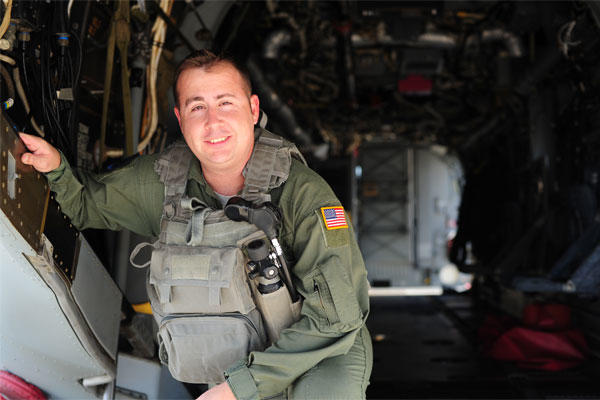HURLBURT FIELD, Fla. -- There's a saying -- "a journey begins with a single step."
For a flight engineer assigned to the 8th Special Operations Squadron here, even a single step seemed like a lofty goal at one time.
After Tech. Sgt. Christofer Curtis' CV-22 Osprey crashed during a mission in Afghanistan in April 2010, he was left with numerous serious injuries and uncertainty surrounding whether he would walk again.
Now, almost three years to the date of his crash, he has returned to the sky.
"We crashed and lost the aircraft, but more importantly lost four individuals along with it," Curtis said. "Since then, I've obviously been on the road to recovery. Seventeen broken bones will do that to you."
After being evacuated from the battlefield to Landstuhl Regional Medical Center, Germany, Curtis was airlifted to then- Walter Reed Army Medical Center, Md., where he awoke from a coma. From the beginning of his recovery, Curtis said he decided not only would he walk again, but he would walk through the doors of his squadron.
"I was in the surgical intensive care unit when someone asked me, 'Are you going to get back up again?'" Curtis said. "I said, 'Not only am I going to get back up -- goal number one (is) to walk through my squadron's doors.' I did happen to accomplish that the same year, October 2010. Then they asked, 'What's your second goal?' And my second goal was literally today, it was to fly again."
Curtis said his natural mental resiliency was further strengthened by the encouragement he received from visitors and other wounded warriors while in the hospital.
"I had a lot of folks at Walter Reed come in to visit me and share their experiences of the do's and do not's of getting better, and I've learned to basically just stay positive," Curtis said. "Staying positive not only will it help you mentally, it will help you physically."
After leaving WRAMC, Curtis was sent on to Brooks Army Medical Center in San Antonio, Texas, for the next almost year-long stage of his recovery. His physical resiliency was refined as he received therapy to help him achieve milestones, like being able to prepare his own meals. Now, reflecting back on the countless hours of physical therapy, the result was worth it.
"I feel great, but at the same time I do feel remnants of that pain," Curtis said.
The care providers, therapy he received and even comments from naysayers were integral to his recovery, he said. "Without them I wouldn't even be close to here."
Once back at Hurlburt Field, Curtis worked with his unit to determine he was physically capable of returning to his job as a flight engineer responsible for maintaining the health of the CV-22 during flight. As he geared up for his first training flight, there were no visible jitters, just a slight stumble with putting on a new type of harness, the only indication Curtis had spent any time away from flying.
"I just did what I normally do, what I remembered normally doing, which is just getting up and thinking about the mission and my role, everything the Air Force taught me," Curtis said describing his preflight preparations.
While some questioned Curtis' drive and dedication to return to his job, his mental strength helped him push aside any doubts.
"I felt (in my) body and mind this is where I need to be and what I need to do," Curtis said.
After the flight, though Curtis had yet to hear his instructor's evaluations of his performance, both were all smiles.
"It isn't just me getting in the air," Curtis said postflight. "It's saying that I've made it this far physically, and mentally, as a bigger success. Flying, in the end, is something I always loved and will continue to do. I won't ever forget the path it took and the people I've met to get to this point."
Now in the position to pay it forward by relaying advice to other wounded warriors, Curtis offers what helped him most to get through his own challenges.
"Continue to stay positive and establish challenging but attainable goals," Curtis said. "More importantly, understand that you will have good days and bad days, but stay the course as it will pay off in the end."
On the road to regaining his flight qualifications, Curtis now looks forward to the normalcy of returning to the job he loves. Next on his radar: being assigned as part of aircrew charged with accepting new aircraft for the Air Force.




























